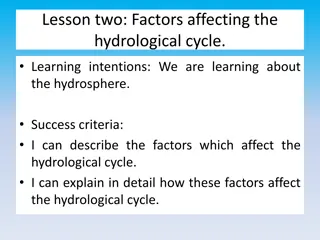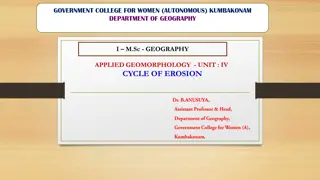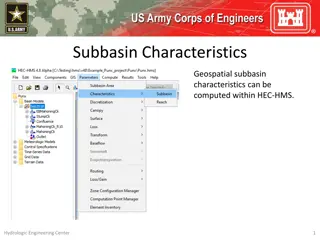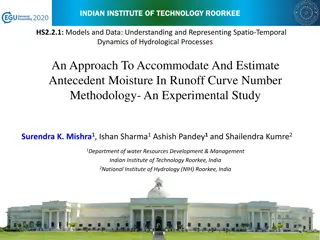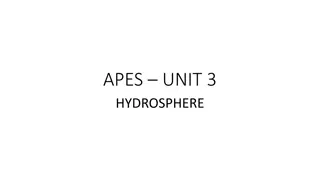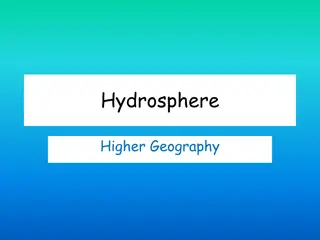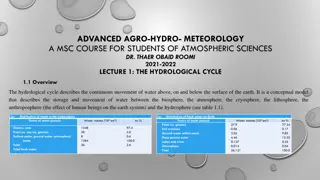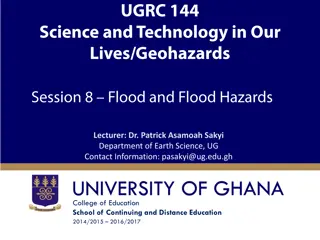Understanding the Hydrological Cycle: An Introduction by Ayansa T.
Ayansa T., a lecturer at Ambo University Woliso Campus, provides an insightful overview of the hydrological cycle in this introduction. Exploring the stages of the cycle, such as precipitation, infiltration, and evaporation, Ayansa delves into the water budget equation and its importance in hydrological calculations. The chapter outlines the significance of studying hydrology and the processes involved in the distribution of water on Earth and its atmosphere.
Download Presentation

Please find below an Image/Link to download the presentation.
The content on the website is provided AS IS for your information and personal use only. It may not be sold, licensed, or shared on other websites without obtaining consent from the author. Download presentation by click this link. If you encounter any issues during the download, it is possible that the publisher has removed the file from their server.
E N D
Presentation Transcript
CHAPTER ONE INTRODUCTION By Ayansa T. (B.Sc. In Met. And HYDR., M.Sc. in WRE) Lecturer at Ambo University Woliso Campus, Civil Eng.
Introduction Hydro+ logos (Both are Greek words) Hydro means water and logos means study. Hydrology is a science which deals with the occurrence, circulation and Distribution of water of the earth and earth s atmosphere. Hydrological Cycle: It is also known as water cycle. A Continuous process in which water is evaporated from water surfaces and the oceans, moves in land as moist air masses, and produces precipitation, if the correct vertical lifting conditions exist.
Stages of the Hydrologic cycle Precipitation Infiltration Interception Depression storage Run-off Evaporation Transpiration Groundwater
Water Budget/Balance Equation The area of land draining into a stream or a watercourse at a given location is known as catchment area. It is also called as drainage area or drainage basin. For a given problem area, say a catchment, in an interval of time t, the continuity equation for water in its various phases is written as.
Water Budget/Balance Equation If the density of the inflow, outflow and storage volumes are the same ? 0= ? Where ?=Inflow volume of water into the problem area during the time period, 0=Outflow volume to water from the problem area during the time period, and ?=change in the storage of the water volume over and under the given area during the given period.
Water Budget/Balance Equation In hydrologic calculations, the volumes are often expressed as average depths over the catchment area. Thus, for example, if the annual stream flow from a 10km2 catchment is 107m3, it corresponds to a depth of 107 10 106= 1? = 100?? Rainfall, evaporation and often runoff volumes are expressed in units of depth over the catchment. While realizing that all the terms in a hydrological water budget may not be known to the same degree of accuracy, an expression for the water budget of a catchment for a time interval t is written as
Water Budget in Land surface ? ? = ? (? + ?1+??) ?2+ ??+ ??+ ? = ?? Water Budget in Groundwater ? ? = ? (? + ?1) ?2+ ??+ ??+ ?? = ?? ? ?2 ?1 ??+ ?? ??+ ?? ?2 ?1 = ??+ ?? R (Net Surface Flow)=?2 ?1 E (Net Evaporation) =??+ ?? T (Net Transpiration)=??+ ?? G (Net Groundwater Flow)=?2 ?1 ??+ ?? P-R-E-T-G= S This Equation is the water budget equation for the catchment.
Water Budget/Balance Equation Note that all these terms can be expressed as depth over the catchment area, (for Eq. in centimeters), and in fact this is a very common unit. Further, the infiltration does not occur explicitly in the water budget as the infiltration, which is a loss to the runoff process is a gain to the ground water system.
Example 1: a lake had a water surface elevation of 103.200 m above datum at the beginning of a certain month. In that month the lake received an average inflow of 6.0 m3/s from surface runoff sources. In the same period the outflow from the lake had an average value of 6.5m3/s. Further, in that month, the lake received a rainfall of 145 mm and The evaporation from the lake surface was estimated as 6.10cm. Write the water budget equation for the lake and calculate the water surface elevation of the lake at the end of the month. The average lake surface area can be taken as 5000 ha. Assume that there is no contribution to or from the ground water storage.
Water Budget/Balance Equation Solution: In a time period ? the water budget for the lake can be written as ????? ?????? ?????? ?????? = ?????? ?? ??????? where ?= average inflow rate, ?= average outflow rate, P = precipitation, E = evaporation, A = surface area of the lake and S = change in lake storage volume.
Here t = 1 month = 30 x 24 x 60 x 60 = 2.592x106s = 2.592 Ms In one month: = = = 3 0 . 6 . 2 x 592 15 552 . Inflow volume I t M m = = = 3 5 . 6 . 2 x 592 16 . 848 Outflow vlume Q t M m 14 5 . 5000 100 100 x x x = = = 3 3 . 7 25 Input due to precipitat ion PA M m M m 6 100 10 x . 6 10 5000 100 100 x x = = = 3 . 3 05 outflow due to evaporatio n EA x M m 6 100 10 = + = 3 Hence 15 552 . . 7 25 16 848 . . 3 05 . 2 904 S M m 6 . 2 904 10 S x = = = Change in elevation . 0 058 m z 5000 100 100 A x x New water surface elevation at the end of the month = 103.200 + 0.058 = 103.258m above the datum.



